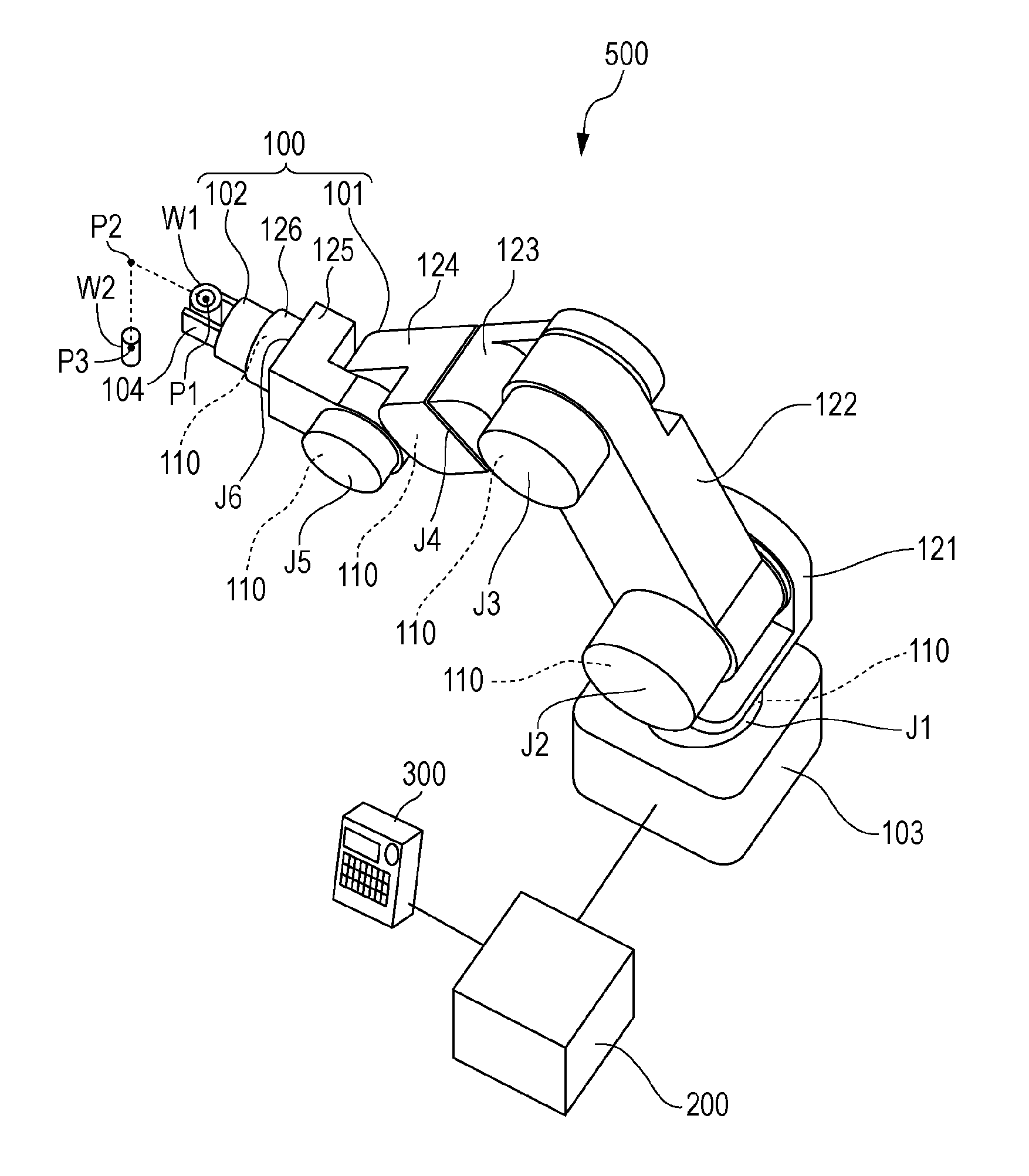Robot controlling method, robot apparatus, program, recording medium, and method for manufacturing assembly component
a robot and control method technology, applied in the field of robot control methods, can solve the problems of low rigidity, deteriorating assembly work precision in some cases, and difficult to ensure that the vibrations of the leading end have converged, so as to improve the work efficiency improve the work precision of the articulated robo
- Summary
- Abstract
- Description
- Claims
- Application Information
AI Technical Summary
Benefits of technology
Problems solved by technology
Method used
Image
Examples
first exemplary embodiment
[0024]Hereinafter, a robot apparatus according to an exemplary embodiment of the present invention will be described. FIG. 1 is a perspective view illustrating a robot apparatus according to a first exemplary embodiment of the present invention.
[0025]A robot apparatus 500 illustrated in FIG. 1 is an industrial robot. The robot apparatus 500 includes a robot 100, a control device 200, and a teaching pendant 300. The robot 100 carries out assembly work in which the robot 100 assembles a first part W1, which is held by the robot 100, and a second part W2. The control device 200, which serves as a control unit, controls the robot 100. The teaching pendant 300 is connected to the control device 200.
[0026]The robot 100, which is an articulated robot, includes a vertically articulated robot arm 101 and a robot hand 102, which is an end effector, connected to the leading end of the robot arm 101.
[0027]A tool center point (TCP) is set at a leading end of the robot 100 (the leading end of the...
second exemplary embodiment
[0076]Subsequently, a robot controlling method for a robot apparatus according to a second exemplary embodiment of the present invention will be described with reference to FIGS. 7 and 8. FIG. 7 is a functional block diagram illustrating a control system of the robot apparatus according to the second exemplary embodiment of the present invention. FIG. 8 is a flowchart illustrating each of the steps in the robot controlling method implemented by a control device according to the second exemplary embodiment of the present invention. It is to be noted that the overall configuration of the robot apparatus according to the second exemplary embodiment is similar to the configuration of the robot apparatus 500 according to the first exemplary embodiment; thus, descriptions thereof will be omitted and the following description centers on points that differ from those of the first exemplary embodiment. The second exemplary embodiment differs from the first exemplary embodiment in terms of th...
third exemplary embodiment
[0095]Subsequently, a robot controlling method for a robot apparatus according to a third exemplary embodiment of the present invention will be described with reference to FIGS. 9 and 10. FIG. 9 is a functional block diagram illustrating a control system of the robot apparatus according to the third exemplary embodiment of the present invention. FIG. 10 is a flowchart illustrating each of the steps in the robot controlling method implemented by a control device according to the third exemplary embodiment of the present invention. It is to be noted that the overall configuration of the robot apparatus according to the third exemplary embodiment is similar to the configuration of the robot apparatus 500 according to the first exemplary embodiment; thus, descriptions thereof will be omitted and the following description centers on points that differ from those of the first exemplary embodiment. The third exemplary embodiment differs from the first exemplary embodiment in terms of the f...
PUM
| Property | Measurement | Unit |
|---|---|---|
| output angle | aaaaa | aaaaa |
| detection angles | aaaaa | aaaaa |
| time | aaaaa | aaaaa |
Abstract
Description
Claims
Application Information
 Login to View More
Login to View More - R&D
- Intellectual Property
- Life Sciences
- Materials
- Tech Scout
- Unparalleled Data Quality
- Higher Quality Content
- 60% Fewer Hallucinations
Browse by: Latest US Patents, China's latest patents, Technical Efficacy Thesaurus, Application Domain, Technology Topic, Popular Technical Reports.
© 2025 PatSnap. All rights reserved.Legal|Privacy policy|Modern Slavery Act Transparency Statement|Sitemap|About US| Contact US: help@patsnap.com



